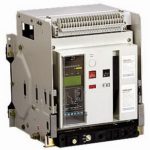1. A circuit breaker is
(A) power factor correcting device
(B) a device to neutralize the effect of transients
(C) a waveform correcting device
(D) a current interrupting device.
2. The function of protective relay in a circuit breaker is
 (A) to each any stray voltages
(A) to each any stray voltages
(B) to close the contacts when the actuating quantity reaches a certain predetermined value
(C) to limit arcing current during the operation of circuit breaker
(D) to provide additional safety in the operation of circuit breaker.
3. Low voltage circuit breakers have rated voltage of less than
(A) 220 V
(B) 400V
(C) 1000 V
(D) 10,000 V.
4. The fault clearing time of a circuit breaker is usually
(A) few minutes
(B) few seconds
(C) one second
(D) few cycles of supply voltage.
5. The medium employed for extinction of arc in air circuit breaker is
(A) SF6
(B) Oil
(C) Air
(D) Water.
6. Which of the following circuit breakers is preferred for EHT application
(A) Air blast circuit breakers
(B) Minimum oil circuit breakers
(C) Bulk oil circuit breakers
(D) SF6 oil circuit breakers.
7. For high voltage, ac circuit breakers, the rated short circuit current is passed for
(A) 0.01 sec
(B) 0.1 sec
(C) 3 seconds
(D) 30 seconds.
8. Which of the following is not a type of the contactor for circuit breakers ?
(A) Electro-magnetic
(B) Electro-pneumatic
(C) Pneumatic
(D) Vacuum.
9. Interrupting medium in a contactor may be
(A) air
(B) oil
(C) SF6 gas
(D) any of the above.
10. In air blast circuit breakers, the pressure of air is of the order of
(A) 100 mm Hg
(B) 1 kg/cm2
(C) 20 to 30 kg/cm2
(D) 200 to 300 kg/cm2 .
11. SF6 gas is
(A) sulphur fluoride
(B) sulphur difluoride
(C) sulphur hexafluorine
(D) sulphur hexafluoride.
12. SF6 gas
(A) is yellow in color
(B) has pungent odor
(C) is highly toxic
(D) is non-inflammable.
13. SF6 gas
(A) is lighter than hydrogen
(B) is lighter than air
(C) has density 2-times as compared to that of air
(D) has density 5 limes as compared to that of air.
14. The pressure of SF6 gas in circuit breakers is of the order of
(A) 100 mm Hg
(B) 1 kg/cm2
(C) 3 to 5 kg/cm2
(D) 30 to 50 kg/cm2.
15. While selecting a gas for circuit breaker, the property of gas that should be considered is
(A) high dielectric strength
(B) non-inflammability
(C) non-toxicity
(D) all of the above.




